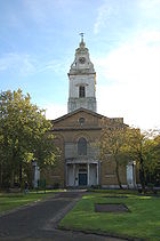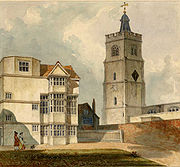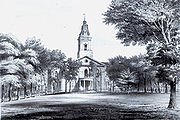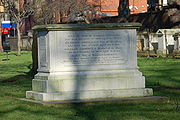
Church of St John-at-Hackney
Encyclopedia
The Church of St John at Hackney is situated in the London Borough of Hackney
. It was built in 1792, in an open field, north east of Hackney
's medieval parish church, of which only St Augustine's Tower
remains. Separated by the southern extension of Lower Clapton Road, it looks north to the late Georgian
Clapton Square
.
was the largest in Middlesex. The vast, classical style building, on a Greek cross plan, can hold 2,000 people.
The former churchyard is now a complex of gardens that was awarded Heritage Green Site Status in 2008. The building is Grade II* listed and houses monuments dating from Tudor times – transferred from the former church – and other more recent memorials.

, before the Norman Conquest, but no records survive of any building before 1275 and any prior church would have been a part of the parish of Stepney
. From the 14th century the church was dedicated to St Augustine of Hippo until, after 1660, it was rededicated to St John the Baptist, later becoming more commonly known as St John-at-Hackney.
In the 13th century, much of the land around Hackney formed part of the possessions of the Knights Templars. When the order was disbanded, their possessions were passed to the Order of St John of Jerusalem, who had a mansion on Church Street. The Order of St John began with the First Crusade to the Holy Land in 1095. When the Crusaders captured Jerusalem and founded a hospice. In 1113, the Pope recognised it as an independent religious order of monks and nuns, The Order of St John, whose special task was to care for the sick. At the dissolution
, the lands passed to the Crown, and were parcelled amongst Tudor nobles, including Thomas Sutton
and Ralph Sadleir.
 In 1779, a surveyor, Richard Jupp proposed a rebuilding to increase the capacity to 1,480, but no action was taken. By 1788, a committee found that the population of the parish had increased so much that the church should seek to seat 3,000. The appointed architect, William Blackburn
In 1779, a surveyor, Richard Jupp proposed a rebuilding to increase the capacity to 1,480, but no action was taken. By 1788, a committee found that the population of the parish had increased so much that the church should seek to seat 3,000. The appointed architect, William Blackburn
, firmly rejected the idea of building on the old site, advising that a budget of £15,000 be created to buy land on which to construct a new church.
April 1789 the committee put the matter to a parochial vote. winning their case by 313 votes to 70, and a Bill was put to the House of Commons. Opponents of the proposal undertook yet another survey with a view to rebuild on the old site. Finally, a compromise was reached; the Bill became an Act empowering the Trustees to acquire, for £875, Church Field which lay to the north-east of the existing churchyard. The existing tenants, a butcher and corn chandler, were given three months to leave.
 A new church, tower and vestry room would be built within three years of laying the foundation, and then the old church demolished. In the event the initial estimates of costs were badly out and two further Acts had to be passed through Parliament to allow extra money to be raised.
A new church, tower and vestry room would be built within three years of laying the foundation, and then the old church demolished. In the event the initial estimates of costs were badly out and two further Acts had to be passed through Parliament to allow extra money to be raised.
William Blackburn died suddenly in November 1790; a month later James Spiller, influenced by and a friend of John Soane
, was chosen from six architect candidates. Hackney church was his largest project to date and remained his magnum opus. Believing that a building seating 3,000 would have poor acoustics, he persuaded the Trustees to allow him to reduce the capacity to 2,000, but remained convinced that the acoustics would not be good unless the church was full.
Work began in spring 1792, and the main structure took more than two years to complete. On 15 July 1797, the church was consecrated, with a wooden box-like structure where the tower would later be added.
 Harry Sedgwick, a trustee, oversaw a subscription for planting the churchyard. 129 subscriptions enabled nearly 200 elms and horse chestnuts to be planted in avenues. Sedgwick was later buried in the churchyard; and his planting achievement is commemorated on his tomb. Sedgwick lost his only son in action in the Napoleonic War, he has an elaborate memorial inside the church.
Harry Sedgwick, a trustee, oversaw a subscription for planting the churchyard. 129 subscriptions enabled nearly 200 elms and horse chestnuts to be planted in avenues. Sedgwick was later buried in the churchyard; and his planting achievement is commemorated on his tomb. Sedgwick lost his only son in action in the Napoleonic War, he has an elaborate memorial inside the church.
In March 1798, the body of the old church was demolished and several of the tombs removed to the new church. The tower remained - left intact to hold the bells, as funds did not run to building a tower on the new church. In 1814, the tower was added to the church, and in 1816, a stained glass east window was installed behind the altar.
The old tower of St Augustine's Church remains standing to this day and plays a symbolic and ceremonial role in Hackney: It has adorned the masthead of the Hackney Gazette since its foundation in 1864 and is incorporated in the coat of arms of the London Borough of Hackney
.
 On 18 May 1955, a fire started in the church roof, destroying the roof, many of the pews and the 1799 organ, by George Pike England. During the ensuing major reconstruction work there was some reordering of the interior.
On 18 May 1955, a fire started in the church roof, destroying the roof, many of the pews and the 1799 organ, by George Pike England. During the ensuing major reconstruction work there was some reordering of the interior.
A replacement three manual Mander organ came from All Saint's Ennismore Gardens, Kensington
; altar hangings designed for the coronation of Queen Elizabeth II
at Westminster Abbey
were donated; and the east window replaced by a new one designed by Christopher Webb. The new church was reconsecrated on 24 June 1958 (St John's Day).
Repair work was carried out on the roof, in 2004, funded by English Heritage
; and an electrical fire in January 2006, caused minor damage to the church – but the organ still needs to be checked for smoke damage. The fabric of the 200–year old church still requires major maintenance, and the parish has prepared an action plan to raise money and proceed with refurbishment and adaptation of the building to the modern needs of the parish.
At the Church fete on 5 July 2008, the church and its churchyard were re-dedicated by the Archdeacon of Hackney, in celebration of the fiftieth anniversary of the reconstruction and the major works undertaken to regenerate the church gardens over the previous year. St John's Church Gardens, around the tower and church were awarded both a Green Flag award
, and Green Flag Heritage status, in 2008.

Dr Lincoln Harvey and Sebastian Ejiaku are both assistant clergy.
Fr Chris Ferris is Associate Rector and Chaplain to the Urswick School.
Emily Ovenden is the Parish Administrator.
Babs Scott Wollaston is the Reader Emeritus.
St John at Hackney is now overseeing the St John at Hackney project, launched in June 2008. This is a five year plan to make the building fit for purpose, along with several community ministry projects.
is Hackney Central
London Borough of Hackney
The London Borough of Hackney is a London borough of North/North East London, and forms part of inner London. The local authority is Hackney London Borough Council....
. It was built in 1792, in an open field, north east of Hackney
Hackney Central
Hackney Central is the central district of the London Borough of Hackney in London, England. It comprises the area roughly surrounding, and extending north from Mare Street. It is situated north east of Charing Cross...
's medieval parish church, of which only St Augustine's Tower
St Augustine's Tower Hackney
St Augustine's Tower stands in St John's Church Gardens, in Hackney Central, in the London Borough of Hackney, just off the southern end of the Narrow Way . It is all that remains of the early 16th century parish church of Hackney of St Augustine, which replaced the 13th century medieval church...
remains. Separated by the southern extension of Lower Clapton Road, it looks north to the late Georgian
Georgian era
The Georgian era is a period of British history which takes its name from, and is normally defined as spanning the reigns of, the first four Hanoverian kings of Great Britain : George I, George II, George III and George IV...
Clapton Square
Clapton Square
The Clapton Square Conservation Area, Hackney, was designated in 1969 and extended in 1991 & 2000. It is protected by Acts of Parliament as a London Square. It is dominated by the Church of St John-at-Hackney built in 1792-97, and St John’s Gardens. Its made up of listed late Georgian terraces on...
.
History
The Church of St John-at-Hackney was designed by James Spiller, and built in 1792. At this time, Hackney ParishHackney (parish)
Hackney was a parish in the historic county of Middlesex. The parish church of St John-at-Hackney was built in 1789, replacing the nearby former 16th century parish church dedicated to St Augustine . The original tower of that church was retained to hold the bells until the new church could be...
was the largest in Middlesex. The vast, classical style building, on a Greek cross plan, can hold 2,000 people.
The former churchyard is now a complex of gardens that was awarded Heritage Green Site Status in 2008. The building is Grade II* listed and houses monuments dating from Tudor times – transferred from the former church – and other more recent memorials.

St Augustine's Church
It is possible that a church stood here, in this small but wealthy village north of the City of LondonCity of London
The City of London is a small area within Greater London, England. It is the historic core of London around which the modern conurbation grew and has held city status since time immemorial. The City’s boundaries have remained almost unchanged since the Middle Ages, and it is now only a tiny part of...
, before the Norman Conquest, but no records survive of any building before 1275 and any prior church would have been a part of the parish of Stepney
St Dunstan's, Stepney
St Dunstan's, Stepney is an Anglican Church which stands on a site which has been used for Christian worship for over a thousand years. It is located in Stepney High Street, in Stepney, London Borough of Tower Hamlets.-History:...
. From the 14th century the church was dedicated to St Augustine of Hippo until, after 1660, it was rededicated to St John the Baptist, later becoming more commonly known as St John-at-Hackney.
In the 13th century, much of the land around Hackney formed part of the possessions of the Knights Templars. When the order was disbanded, their possessions were passed to the Order of St John of Jerusalem, who had a mansion on Church Street. The Order of St John began with the First Crusade to the Holy Land in 1095. When the Crusaders captured Jerusalem and founded a hospice. In 1113, the Pope recognised it as an independent religious order of monks and nuns, The Order of St John, whose special task was to care for the sick. At the dissolution
Dissolution of the Monasteries
The Dissolution of the Monasteries, sometimes referred to as the Suppression of the Monasteries, was the set of administrative and legal processes between 1536 and 1541 by which Henry VIII disbanded monasteries, priories, convents and friaries in England, Wales and Ireland; appropriated their...
, the lands passed to the Crown, and were parcelled amongst Tudor nobles, including Thomas Sutton
Thomas Sutton
Thomas Sutton was an English civil servant and businessman as well as being the founder of Charterhouse School. He was the son of an official of the city of Lincoln, and was educated at Eton College and probably at Cambridge...
and Ralph Sadleir.
Growing congregation
Hackney's proximity to the City of London and the court made it popular with courtiers, city merchants and businessmen, and for an increasing number of private schools which were established in some of the older houses. By 1789, the church capacity, with the addition of numerous galleries, had reached 1,000. This however was not enough.
William Blackburn
William Blackburn was the leading prison architect of the Georgian Era. Following the principles of John Howard, his designs aimed to provide inmates with dry and airy cells....
, firmly rejected the idea of building on the old site, advising that a budget of £15,000 be created to buy land on which to construct a new church.
April 1789 the committee put the matter to a parochial vote. winning their case by 313 votes to 70, and a Bill was put to the House of Commons. Opponents of the proposal undertook yet another survey with a view to rebuild on the old site. Finally, a compromise was reached; the Bill became an Act empowering the Trustees to acquire, for £875, Church Field which lay to the north-east of the existing churchyard. The existing tenants, a butcher and corn chandler, were given three months to leave.
New church

William Blackburn died suddenly in November 1790; a month later James Spiller, influenced by and a friend of John Soane
John Soane
Sir John Soane, RA was an English architect who specialised in the Neo-Classical style. His architectural works are distinguished by their clean lines, massing of simple form, decisive detailing, careful proportions and skilful use of light sources...
, was chosen from six architect candidates. Hackney church was his largest project to date and remained his magnum opus. Believing that a building seating 3,000 would have poor acoustics, he persuaded the Trustees to allow him to reduce the capacity to 2,000, but remained convinced that the acoustics would not be good unless the church was full.
Work began in spring 1792, and the main structure took more than two years to complete. On 15 July 1797, the church was consecrated, with a wooden box-like structure where the tower would later be added.

In March 1798, the body of the old church was demolished and several of the tombs removed to the new church. The tower remained - left intact to hold the bells, as funds did not run to building a tower on the new church. In 1814, the tower was added to the church, and in 1816, a stained glass east window was installed behind the altar.
The old tower of St Augustine's Church remains standing to this day and plays a symbolic and ceremonial role in Hackney: It has adorned the masthead of the Hackney Gazette since its foundation in 1864 and is incorporated in the coat of arms of the London Borough of Hackney
London Borough of Hackney
The London Borough of Hackney is a London borough of North/North East London, and forms part of inner London. The local authority is Hackney London Borough Council....
.
Major fire damage

A replacement three manual Mander organ came from All Saint's Ennismore Gardens, Kensington
Kensington
Kensington is a district of west and central London, England within the Royal Borough of Kensington and Chelsea. An affluent and densely-populated area, its commercial heart is Kensington High Street, and it contains the well-known museum district of South Kensington.To the north, Kensington is...
; altar hangings designed for the coronation of Queen Elizabeth II
Elizabeth II of the United Kingdom
Elizabeth II is the constitutional monarch of 16 sovereign states known as the Commonwealth realms: the United Kingdom, Canada, Australia, New Zealand, Jamaica, Barbados, the Bahamas, Grenada, Papua New Guinea, the Solomon Islands, Tuvalu, Saint Lucia, Saint Vincent and the Grenadines, Belize,...
at Westminster Abbey
Westminster Abbey
The Collegiate Church of St Peter at Westminster, popularly known as Westminster Abbey, is a large, mainly Gothic church, in the City of Westminster, London, United Kingdom, located just to the west of the Palace of Westminster. It is the traditional place of coronation and burial site for English,...
were donated; and the east window replaced by a new one designed by Christopher Webb. The new church was reconsecrated on 24 June 1958 (St John's Day).
Repair work was carried out on the roof, in 2004, funded by English Heritage
English Heritage
English Heritage . is an executive non-departmental public body of the British Government sponsored by the Department for Culture, Media and Sport...
; and an electrical fire in January 2006, caused minor damage to the church – but the organ still needs to be checked for smoke damage. The fabric of the 200–year old church still requires major maintenance, and the parish has prepared an action plan to raise money and proceed with refurbishment and adaptation of the building to the modern needs of the parish.
At the Church fete on 5 July 2008, the church and its churchyard were re-dedicated by the Archdeacon of Hackney, in celebration of the fiftieth anniversary of the reconstruction and the major works undertaken to regenerate the church gardens over the previous year. St John's Church Gardens, around the tower and church were awarded both a Green Flag award
Green Flag award
The Green Flag Award is the benchmark national standard for parks and green spaces in the United Kingdom. The scheme was set up in 1996 to recognise and reward green spaces in England and Wales that met the laid down high standards...
, and Green Flag Heritage status, in 2008.

Current clergy
Fr Rob Wickham was inducted as Rector of Hackney in March 2007.Dr Lincoln Harvey and Sebastian Ejiaku are both assistant clergy.
Fr Chris Ferris is Associate Rector and Chaplain to the Urswick School.
Emily Ovenden is the Parish Administrator.
Babs Scott Wollaston is the Reader Emeritus.
St John at Hackney is now overseeing the St John at Hackney project, launched in June 2008. This is a five year plan to make the building fit for purpose, along with several community ministry projects.
Other burials
- David DolbenDavid Dolben-Life:He was born at Segrwyd, near Denbigh, son of Robert Wynn Dolben. In 1602 he was admitted as a sizar to St. John's College, Cambridge, graduating B.A. in 1606 and M.A. 1609. On 18 January 1618 he was appointed vicar of Hackney, Middlesex, a benefice he held until May 1633. In 1621 he was made...
, a WelshWelsh peopleThe Welsh people are an ethnic group and nation associated with Wales and the Welsh language.John Davies argues that the origin of the "Welsh nation" can be traced to the late 4th and early 5th centuries, following the Roman departure from Britain, although Brythonic Celtic languages seem to have...
Bishop of BangorBishop of BangorThe Bishop of Bangor is the Ordinary of the Church in Wales Diocese of Bangor.The diocese covers the counties of Anglesey, most of Caernarfonshire and Merionethshire and a small part of Montgomeryshire...
- where his monument, containing a half-length statue and a eulogistic description of him, still remains. - Timothy Hall (bishop)Timothy Hall (bishop)-Life:The son of a wood-turner and householder of St. Katharine's, near the Tower, a precinct of St. Botolph, Aldgate, he was born probably in 1637. He was admitted student of Pembroke College, Oxford, in 1654, then under presbyterian influence, where he took a B.A...
External links
The nearest London Overground stationLondon Overground
London Overground is a suburban rail network in London and Hertfordshire. It has been operated by London Overground Rail Operations since 2007 as part of the National Rail network, under the franchise control and branding of Transport for London...
is Hackney Central
Hackney Central railway station
Hackney Central railway station is a railway station on the North London Line in an area of the London Borough of Hackney known as Hackney Central in east London. It is between and , in Travelcard Zone 2. The station and all trains serving it are operated by London Overground.The station is a...

